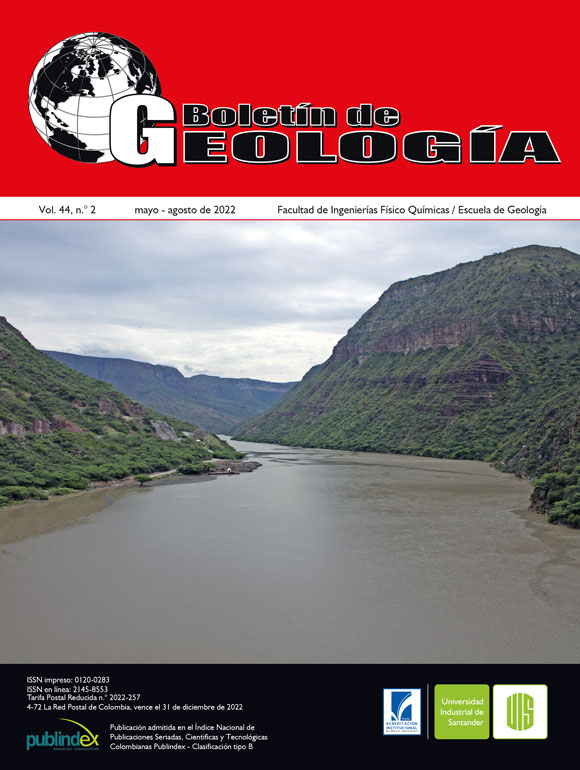Organic geochemistry, lithofacies and gas shale reservoir potential of cretaceous outcrops from Alto de los Caballeros section, Eastern Cordillera Basin – Colombia
Published 2022-07-07
Keywords
- La Frontera Formation,
- Conejo Formation,
- Unconventional reservoirs
How to Cite

This work is licensed under a Creative Commons Attribution 4.0 International License.
Altmetrics
Abstract
Significant layers of shale are exposed in the Eastern Cordillera of Colombia. These Upper Cretaceous rocks from La Frontera and Conejo Formations in the Chécua-Lenguazaque Syncline, between Ubaté, Carmen de Carupa and Sutatausa towns, were evaluated using geochemical and petrographic analysis to determine their potential as gas shale reservoirs. This structure presents promising characteristics for developing a gas shale reservoir due to its areal extension, the existence of a thick layer of marine cretaceous sequence, and a near location to industrial areas, such as the colombian andean region. In La Frontera and Conejo Formations, the result of outcrop samples analysis indicates that some levels meet the geochemical characteristics required for the existence of potential gas shale reservoirs. One of these levels correspond to the base of La Frontera Formation, where limestones exhibit appropriated organic matter content and maturity conditions for gas shale. In addition, this limestone also presents micro-porosity associated with diagenetic processes and kerogen. The geochemical and petrographic features are similar to those found in the Barnett gas shale. The geochemical and petrographic characteristics reflected by the limestones of La Frontera Formation agree with the criteria described and evaluated internationally for unconventional gas shale reservoirs, similar to those found in the Barnett gas shale, and shows the best conditions for the development of these deposits. Nevertheless, it is necessary to evaluate other petrophysical properties, gas saturation, and effective gas permeability in reservoir condition in order to make a conclusive determination about gas shale potential.
Downloads
References
- Askenazi, A.; Biscayart, P.; Cáneva, M.; Montenegro, S.; Moreno, M. (2013). Analogía entre la Formación Vaca Muerta y shale gas/oil plays de EE. UU. Society of Petroleum Engineers (SPE).
- Barrero, D.; Pardo, A.; Vargas, C.; Martínez, J. (2007). Colombia Sedimentary Basins: Nomenclature, Boundaries and Petroleum Geology, a new proposal. Agencia Nacional de Hidrocarburos.
- Behar, F.; Beaumont, V.; Penteado, H. (2001). Rock-Eval 6 technology: performances and developments. Oil & Gas Science and Technology, 56(2), 111-134. https://doi.org/10.2516/ogst:2001013
- Carvajal-Ortiz, H.; Gentzis, T. (2015). Critical considerations when assessing hydrocarbon plays using Rock-Eval pyrolysis and organic petrology data: Data quality revisited. International Journal of Coal Geology, 152(Part A), 113-122. https://doi.org/10.1016/j.coal.2015.06.001
- Curtis, J.B. (2002). Fractured shale-gas systems. AAPG Bulletin, 86(11), 1921-1938.
- Folk, R. (1974). Petrology of Sedimentary rocks. Hemphill Publishing Co.
- García, M. (2010). Shale Gas Potential in the Eastern Cordillera of Colombia. AAPG International Conference and Exhibition, Calgary, Canada.
- Guiza, S.; Vargas, G. (2016). Non-conventional hydrocarbon generation from Cretaceous Shale in the Cordillera Oriental, XRF and XRD application.
- Hill, R.; Jarvie, D.; Zumberge, J.; Henry, M.; Pollastro, R. (2007). Oil and gas geochemistry and petroleum systems of the Fort Worth Basin. AAPG Bulletin, 91(4), 445-473. https://doi.org/10.1306/11030606014
- Jarvie, D.M. (1991). Total organic carbon (TOC) analysis: Geochemical Methods and Exploration. In: R.K. Merril (ed.). Source and Migration Processes and Evaluation Techniques (pp. 113-118). AAPG Special Volumes.
- Jiang, C.; Chen, Z.; Lavoie, D.; Percival, J.; Kabanov, P. (2017). Mineral carbon MinC(%) from Rock-Eval analysis as a reliable and cost-effective measurement of carbonate contents in shale source and reservoir rocks. Marine and Petroleum Geology, 83, 184-194. https://doi.org/10.1016/j.marpetgeo.2017.03.017
- Miall, A.D. (1990). Facies analysis. In: Principles of Sedimentary Basin Analysis (pp. 141-248). Springer.
- Montoya, D.; Reyes, G. (2003). Geología de la Plancha 209 Zipaquirá. Informe 2739. Capítulo 4. INGEOMINAS.
- Moreno, M. (2010). Potencial gasífero de las Lutitas del Cretáceo Superior en los sectores Meridional y Norte de la Cordillera Oriental. Tesis de Maestría, Universidad Industrial de Santander, Colombia.
- Peters, K.E. (1986). Guidelines for evaluating petroleum source rock using programmed pyrolysis. AAPG Bulletin, 70(3), 318-329. https://doi.org/10.1306/94885688-1704-11D7-8645000102C1865D
- Peters, K.; Cassa, M. (1994). Applied source rock geochemistry. In: L.B. Magoon.; W.G. Dow (eds.). The Petroleum System – From Source to Trap (pp. 93-120). AAPG Memoir 60.
- Peters, K.; Xia, X.; Pomerantz, A.; Mullins, O. (2016). Geochemistry applied to evaluation of unconventional resources. In: Y.Z. Ma.; S.A. Holditch (eds.). Unconventional oil and gas resources handbook (pp. 71-126). Gulf Professional Publishing.
- Rezaee, R.; Rothwell, M. (2015). Gas shale: global significance, distribution, and challenges. In: R. Rezaee (ed.). Fundamentals of Gas Shale Reservoirs (pp. 1-15). John Wiley and Sons Inc.
- Tarazona, B. (2017). Análisis de sistemas petrolíferos en la Faja Plegada de la Zona Axial de la Cordillera Oriental Colombiana. Tesis, Universidad Industrial de Santander, Colombia.
- Uribe, J.; Sánchez, S. (2019). Evaluación del potencial de generación de hidrocarburos de la Formación Chipaque mediante análisis petrográficos y geoquímicos en la sección estratigráfica expuesta en la vía que del Municipio de Ubaté conduce al Alto de los Caballeros, Departamento de Cundinamarca – Colombia. Tesis, Universidad Industrial de Santander, Bucaramanga, Colombia.

